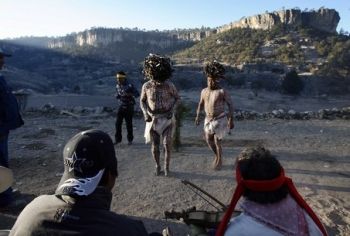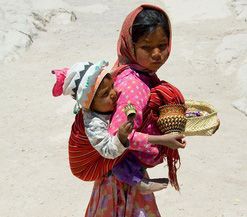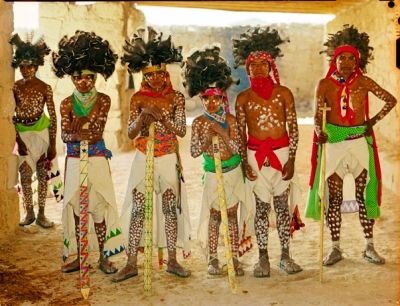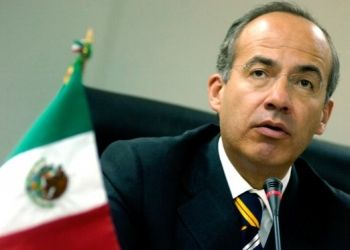
Publisher:
Bonnie King
CONTACT:
Newsroom@Salem-news.com
Advertising:
Adsales@Salem-news.com

~Truth~
~Justice~
~Peace~
TJP
May-19-2011 15:35

 TweetFollow @OregonNews
TweetFollow @OregonNews
Indigenous Mexico Resists
Salem-News.comCommunity leaders demand that the Chihuahua State Legislature approve a constitutional reform and pass an indigenous rights law.
 Tarahumara people - courtesy: Syracuse University |
(LAS CRUCES, N.M.) - From north to south and from east to west, indigenous communities in Mexico are standing up for environmental protection, community defense, cultural survival and self-determination.
 |
Unfolding across the nation, the latest movements spring from the defense of lands targeted for mining, tourist development, highway construction, dams, energy projects and illegal timber harvesting.
“The response is not passivity, but autonomy and collective organization from below,” columnist Gloria Munoz Ramirez recently wrote.
In the northern state of Chihuahua, hundreds of Raramuri (Tarahumara) protesters could soon begin descending from their mountain homeland on the state capital of Chihuahua City.
Community leaders demand that the Chihuahua State Legislature approve a constitutional reform and pass an indigenous rights law that guarantees access to health care, education, housing and other social necessities.
In announcing a march on the state capital possibly this month, Raramuri leaders declared their communities are under siege from rural bosses, drug traffickers, mining companies and loggers.

Numbering about 110,000 people, the Raramuri also suffer from an enduring drought that renders their rain-fed agriculture precarious at best.
In the last two decades, many Raramuri have fled the Sierra Madre mountains for urban settlements in Chihuahua City and Ciudad Juarez.
“We don’t come to beg for alms, we want the law so we could work,” said Raramuri spokesman Ramon Gardea.
A proposed state indigenous law has stalled in Chihuahua’s legislature for 15 years, according to a summary prepared by the Sierra Madre Alliance, a Chihuahua City-based non-governmental organization that supports Raramuri community concerns.
Although a federal law obliges the states to pass conforming legislation on indigenous rights, Chihuahua still lags behind several other entities which have completed the task, Ernesto Palencia, Sierra Madre Alliance spokesman, told Frontera NorteSur.
Palencia said law-makers and non-governmental organizations have been working on the latest version of a state law since last year, but the proposed legislation still lacks the community consultation required by international legal agreements.
“This part hasn’t been done yet,” Palencia emphasized.
As for a possible protest march from the mountains, Palencia said Raramuri communities are sending a message demanding recognition of their ancestral territories. “This is the moment people want to come out and demonstrate,” he said.
In addition to being the historic homeland for the Raramuri and three other native groups, Chihuahua, and especially the state’s largest city of Ciudad Juarez, is also now home to many indigenous migrants from other regions of Mexico.
“What you encounter in Ciudad Juarez is very diverse,” Palencia added. The Raramuri activism builds on a forum organized by the Sierra Madre Alliance in Chihuahua City last fall.
The event drew together representatives of Raramuri communities with supporters from non-governmental organizations like the Frente Democratico Campesino. Jon Izaguirre of the United Nations Office of the High Commissioner for Human Rights gave a presentation.
At the forum, the participants decried land invasions; the lack of official respect for the traditional leadership authority of Raramuri leaders; the absence of a state indigenous law; and ecological damages resulting from the expansion of the Copper Canyon-Sea of Cortes tourist circuit.
The forum demanded upholding the United Nations Declaration on the Rights of Indigenous Peoples and the International Labor Organization’s Convention 169, a binding agreement that requires governments to pursue indigenous policies centered on non-discrimination, cultural recognition and participatory democracy.
“The principles of consultation and participation in Convention No. 169 relate not only to specific development projects,” the International Labor Organization notes, “but also to broader questions of governance, and the participation of indigenous and tribal peoples in public life.”
While Mexico is among 20 nations that have ratified Convention 169, the United States is not.
The Chihuahua City forum also urged special attention on the rights of indigenous women, and adamantly rejected mining projects blamed for environmental degradation and jeopardizing the “well-being of current and future generations.”
In wide berths of Mexico, new mining operations-usually spearheaded by Canadian and other foreign investors-are galvanizing opposition from many indigenous communities on environmental, cultural and political grounds.
Recalling in some ways the Spanish conquistadors’ lust for gold and silver centuries ago, a new mining fever is gripping Mexico as international prices for precious metals soar.
 Chihuahua Governor Cesar Duarte |
According to Chihuahua Governor Cesar Duarte, Mexican, Canadian and British companies are expected to invest more than $1.5 billion in his state alone during 2011,
In a recent letter to Mexican President Felipe Calderon, leaders of the Wixarika (Huichol) people demanded the cancellation of 22 mining projects in north-central Mexico.
The letter’s signers contended that the mines would “profoundly” affect the Catorce Mountains and contaminate sacred springs at the heart of Wixarika culture. The Wixarikas reside in mountainous areas in the states of Nayarit, Jalisco, Durango and Zacatecas.
To the south, in the Pacific coastal state of Guerrero, indigenous communities are also rebelling against planned mines in the Costa Chica and La Montana regions.
Earlier this year, hundreds of community leaders and representatives of allied social organizations gathered in a popular assembly to declare their opposition to future mines reportedly on the planning block by Canadian and British investors.
Since the assembly, the Chilapa-based community radio station Uan Milauk Tlatojili (The True Word) has begun publicizing the “No to Mining” campaign.

In neighboring Michoacan, meanwhile, a tense calm surrounds the Purepecha town of Cheran after weeks of confrontation arising from allegations of illegal logging.
Residents of the town of an estimated 16,000 people have barricaded their community and formed security patrols to guard against attacks by heavily armed loggers allegedly associated with a drug trafficker named “El Guero.”
The crisis erupted after residents of Cheran detained five loggers on April 15. In presumed retaliation, two residents of Cheran were killed and another was wounded in an ambush 12 days later.
A subsequent deployment of federal troops and police was met by a highway blockade put up by residents of another indigenous town reportedly at odds with Cheran and perturbed by the presence of the federales.
Yet the Cheran uprising has received support from other nearby communities and groups in Michoacan and across the country, though food shortages and an inability to conduct business are bringing normal community life to a near stand-still.
 President Felipe Calderon |
In a written appeal to a famous son of Michoacan, President Felipe Calderon, Cheran Mayor Roberto Bautista and other residents demanded the dispatch of Mexican troops and a definitive solution to the long-standing practice of illegal logging.
In a lengthy letter, Bautista and his constituents detailed repeated requests for action from state and federal authorities since 2007.
The letter described an escalating spiral of drug trafficking, kidnapping, livestock rustling illegal logging and even attacks against community firefighters-all under the noses of government authorities.
According to Cheran residents, the illicit tree-cutting has devastated more than 45,000 acres of forest land. Not a single request for help was answered within a reasonable time frame, Mayor Bautista and other residents charged.
“With the passage of time, it had to be through the loss of the lives of communal members of Cheran that there might be attention from the state authorities,” the letter stated.
Land theft and environmentally destructive tree harvesting remain burning issues in other indigenous communities in Michoacan as well, despite years of government pledges to crack down on illegal logging. The previous administration of President Vicente Fox even defined the issue as a matter of national security.
“The criminals arrive with unsigned documents and take control of the lands; they are very well organized,” said Gabriel Mondragon Garcia, communal representative of the community of Zirahuen. “Sometimes they come and threaten us. We are afraid, but we have to struggle to defend our communities.
Utterly amazing video shows the athletic prowess of the Tarahumara. |
We seek to link up with other sister communities.” Suppressed and marginalized for centuries, indigenous Mexicans have become much more vocal and politically active in recent decades.
Marking water-shed moments in modern indigenous history, the 1992 mass protests against the Columbus Quincentennial followed up by the 1994 armed uprising of the Mayan-based Zapatista National Liberation Army in Chiapas ushered in a new era of community mobilization, cultural reaffirmation and assertions of political autonomy.
On a national scale, the formation of the independent National Indigenous Congress gave voice to a new movement as Mexico entered the 21st century. The slogan, “Never again a Mexico without Us,” resonated across the country among many of the nation’s more than 10 million people indigenous people.
In 1995, the Zapatistas and Mexican government signed the San Andres Accords recognizing the right of indigenous Mexico to participate in decisions vital to their lands, customs and communities. Years later, however, the accords are gathering dust on a government shelf.
Not waiting for official policy to change, the Zapatistas and indigenous groups in several other states established their own local governments and chose leaders outside the official political system.
“It gives a glimpse of what could be done if an accord were implemented,” said Dr. Neil Harvey, chair of the government department at New Mexico State University.
According to Harvey, who’s done extensive field research and written widely on the Zapatista movement, the forces of militarization, violence, impunity and imposed economic development threaten indigenous communities across Mexico today. The Mexican government, he added, has prioritized investment and economic growth in sectors like mining.
Harvey said respect for the San Andres Accords and Convention 169 is essential for resolving indigenous grievances and rights and minimizing conflicts.
“As long as indigenous people don’t have the rights to consultation and participation you’re going to see conflict emerging,” Harvey said.
Additional sources:
- El Universal, May 4, 10, 13, 13, 17, 2011. Articles by Alberto Torres and Elly Castillo.
- Proceso/Apro, May 11, 2011.
- La Jornada, March 5, 2011; April 30, 2011; May 3, 4, 5, 10, 14, 2011. Articles by Gloria Munoz Ramirez, Ernesto Martinez Elorriga and Pablo Alarcon Chaires.
- Informados.com, May 3, 2011.
- Lapolaka.com, May 1 and 3, 2011.
- El Sur, February 6, 2011; April 21, 2011. Articles by Jesus Rodriguez Montes, Luis Daniel Nava and
- Agencia Reforma.
Frontera NorteSur: on-line, U.S.-Mexico border news
Center for Latin American and Border Studies
New Mexico State University
Las Cruces, New Mexico
Articles for May 18, 2011 | Articles for May 19, 2011 | Articles for May 20, 2011






Terms of Service | Privacy Policy

All comments and messages are approved by people and self promotional links or unacceptable comments are denied.
[Return to Top]
©2025 Salem-News.com. All opinions expressed in this article are those of the author and do not necessarily reflect those of Salem-News.com.